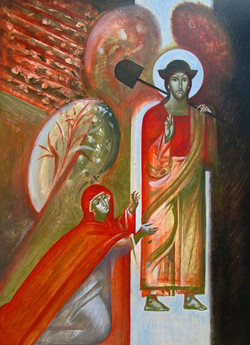
Mary stood at the sepulchre weeping: and as she wept, she stooped down, and looked in, And seeth two angels in white sitting, the one at the head, and the other at the feet, where the body of Jesus had lain. And they say unto her, Woman, why weepest thou? She saith unto them, Because they have taken away my Lord, and I know not where they have laid him. And when she had thus said, she turned herself back, and saw Jesus standing, and knew not that it was Jesus. Jesus saith unto her, Woman, why weepest thou? whom seekest thou? She, supposing him to be the gardener, saith unto him, Sir, if thou have borne him hence, tell me where thou hast laid him, and I will take him away. Jesus saith unto her, Mary. She turned herself, and saith unto him, Rabboni; which is to say, Master. Jesus saith unto her, Touch me not; for I am not yet ascended to my Father: but go to my brethren, and say unto them, I ascend unto my Father, and your Father; and to my God, and your God. (John 20: 11-17, KJV)
My last image of a Post-Resurrection appearance of Christ is an icon of Mary Magdalene's encounter with Jesus at the empty tomb in John the Evangelist's account of Easter Sunday, this time by Andriy Vynnychok from the new school of Ukrainian Greek Catholic iconography in the West Ukrainian city of Lviv. He has chosen the moment depicted in European art under the Italian title, Noli me tangere (Touch Me Not), when Jesus tells Mary not to hold onto him, since he has not yet ascended to the Father. Vynnychok borrows a motif from a 17th century painting by Rembrandt, where Christ, quite literally, is depicted as a gardener in straw hat with spade in hand. This intriguing image of the Resurrection suggests the Risen Christ, as the Second Adam of biblical tradition, has the ground to break in a new Garden of Eden in a new heaven and earth. (John Kohan)